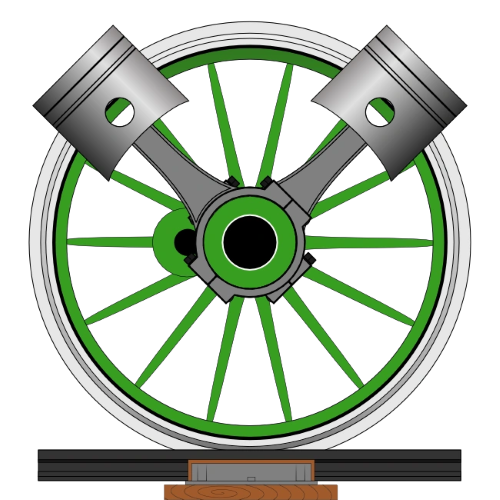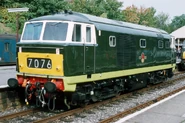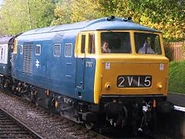
D7076 at the East Lancashire Railway.
The British Rail (BR) Class 35 is a class of mixed-traffic B-B diesel locomotive with hydraulic transmission. Because of their Mekydro-design hydraulic transmission units, the locomotives became known as the Hymeks. They were numbered D7000-D7100.
The class was developed for the Western Region of British Railways, which had opted for lightweight locomotives with hydraulic transmission, when allocated funds under the British Railways Modernisation Plan of 1955. One hundred and one of the class were built between 1961 and 1964, when it became apparent that there was a requirement for a medium power diesel-hydraulic design for both secondary passenger work and freight duties.
They were allocated to Bristol Bath Road, Cardiff Canton, and Old Oak Common. None of the class was named. Withdrawal from service began in 1971, and was completed by 1975. Their early withdrawal was caused, primarily, by BR classifying the hydraulic transmission as non-standard. Four examples survived into preservation.
Development[]
The builder, Beyer Peacock (Hymek) Ltd, was a joint venture between Bristol Siddeley Engines (BSE) (licensed to build Maybach engines), Stone-Platt Industries (licensed to build Mekydro transmissions), and the locomotive manufacturer Beyer, Peacock and Company. At the time they were built, the Hymeks were the most powerful diesel-hydraulic locomotives operating with a single engine – the Maybach MD870. Unlike the higher-powered diesel-hydraulic Warship and Western locomotives in the Western Region fleet (with dual Maybach MD655 engines), the Hymeks were not applied with names, nor based on an existing West German design.
Liveries[]
When first built, the Hymeks were given a more elaborate livery than many of the contemporary British Railways diesel classes. The main body of the locomotive was the standard dark Brunswick green, but with a lime green stripe along the bottom of the bodywork. The roof was medium grey, and the finishing touch was to paint the window surrounds in ivory white. In the early 1960s, yellow warning panels were added to the lower part of the front ends, in accordance with BR's then-new policy. With the advent of the Corporate Identity scheme in 1965 some locomotives received all-over BR Rail blue with small yellow warning panels. This was quickly changed by the return of off-white window surrounds. The final variation was BR blue with full yellow ends, the yellow being extended around the cab side windows.
Not all locomotives received the final blue livery. Numbers 7002, 7013, 7020, 7024 and 7054 (at least) were still in green livery when dismantled at Swindon, whilst photographs of numbers 7003, 7005, 7006, 7008, 7021 and 7060 taken late in their lives whilst still green suggest that these may also not have received a repaint in blue. Some of the green locos did receive the same style of full yellow end, extended round the cab side windows that was applied in the final variation of the blue livery. These included nos. 7000, 7009, 7013, 7014, 7020 and 7092 (at least). 7000 and 7009 eventually received the final blue scheme, 7013 and 7020 were withdrawn in green with full yellow ends. The final colour schemes of 7014 and 7092 are not known.
Of those that were repainted blue, numbers 7007, 7010, 7034, 7036, 7046, 7047, 7051, 7052, 7056, 7057 and 7059 (at least) did not receive the full yellow end, only the small yellow warning panel.
Operational service[]
| 81A
82A 83A 84A 86A | ||
| Code | Name | Quantity |
|---|---|---|
| 81A | Old Oak Common | 23 |
| 82A | Bristol Bath Road | 40 |
| 83A | Newton Abbot | 1 |
| 84A | Laira | 1 |
| 86A | Cardiff Canton | 36 |
| Total: | 101 | |
The type was initially employed on secondary passenger services based around Bristol, such as Paddington to Hereford and semi-fast services to the west of England and Wales. Once they had proved themselves more than capable of handling these duties, they were also assigned to express Paddington-Cardiff-Swansea services, displacing King-class steam locomotives. These duties were heavier than they were designed for, and the Hymeks were displaced when Western and Brush type 4 locomotives became available to allow accelerated timings.
Hymeks also worked pickup freights throughout the Western Region as a mixed-traffic design and were used heavily on inter-regional passenger services. This latter often caused operational problems as they would often terminate in areas where there were no trained staff to handle the locomotive once the rostered crew had 'booked-off'. To avoid these instances, the locomotive would invariably be dispatched back to the nearest Western Region tracks without delay. The Hymeks were capable of operating in multiple, but only with each other. The electro-pneumatic control system (coded "Yellow Triangle") allowed only one trailing locomotive to be controlled (by one driver): some trains were operated by three locomotives (all at the front of the train), but in these cases only two locomotives were connected in multiple, the third having a separate driver.
Hymeks were used all over the Western Region on mixed traffic services from secondary passenger and parcels through express freight to ballast trains. They were common in all parts of the region from Paddington to Bristol/South Wales/Worcester/Hereford. They also worked to Birmingham and the West of England, but were rare west of Plymouth.
Hymeks were notably used in multiple (up to three locomotives) as bankers on the Lickey Incline, propelling mainly freight trains from Bromsgrove to Blackwell. During trials, it was discovered that the Hymeks changed between first and second gear at about the speed required to bank a train up the incline, and so they tended to "hunt" between the two gears. Repeated gear changes under full power caused excessive wear and damage, plus excessive heat in the transmission fluid quickly resulted in the locomotive stopping. The simplest way to avoid excessive wear, and the stopping of a train on the incline, was to lock first gear out of action, via the master switch located in each locomotive's A-end cab. With all Lickey bankers allocated to Worcester shed, the main group of five locomotives (D7021 - D7025) and any replacements were all turned on the Worcester triangle, so that the A-cab was always aligned up the incline. Once at the bottom of the incline, each train which required banking would be signalled to the banking locomotives by Gloucester Panel Signal Box, so that the banking crew could then determine if it was necessary to lock out first gear on one or more of the locomotives.
Accidents and incidents[]
- D7049 crashed though the Clevedon branch buffers and into Wymams bookstall at Yatton Station whilst hauling a 15:10pm Tavistock jct - Bristol west depot goods, December 1963.
- On 13 July 1969, locomotive No. D7048 was involved in an accident at Spetchley, Worcestershire.
Withdrawal[]
The aim of the Modernisation Plan, and in particular (the rapid conversion of the entire BR fleet to diesel and electric traction), had been to stem BR's financial losses thought to arise partially from the labour-intensive nature of steam locomotive use. Although steam was eliminated from mainline use by 1968, many unsuitable designs of diesel locomotive had been rushed into service in the rush to achieve steam-free operation. The National Traction Plan of 1967/8 declared that designs proving unreliable, expensive to maintain or non-standard (small or underpowered) should be eliminated as quickly as possible in order to reduce the number of diesel classes from 28 to 15 by the year 1974. The engineering factions of the British Railways Board, the body that oversaw BR's operations from 1962 onwards, felt that all of the Western Region's diesel-hydraulic fleet should be counted as non-standard and should be withdrawn as quickly as possible. This was driven in part by the introduction of Mark 2D air-conditioned carriages, which could only be heated electrically. This requirement for electric train supply (ETS) placed all diesel hydraulic locomotives at a disadvantage compared with diesel electrics. The entire class was withdrawn between 1971 and 1975. Although 26 Hymeks were still around when TOPS was introduced in 1973, they were being withdrawn for being non-standard at the time, so none of the remaining Hymeks were allocated TOPS numbers. They were replaced by Class 37 diesel-electric locomotives made redundant in other regions as a result of a general decline in rail-borne freight traffic throughout the 1960s.
| Year | Quantity in service at |
Quantity withdrawn |
Locomotive numbers | Notes |
|---|---|---|---|---|
| 1971 | 101 | 18 | 7002/6/27/58-60/62-64/66-67/69/72-73/78-79/81/83 | |
| 1972 | 83 | 62 | 7003-5/7-8/10/12-15/19-21/24-25/33-54/56-57/61-65/68/70-71/74/77/80/82/84-88/90-92/94-100 | |
| 1973 | 21 | 13 | 7000/9/17/23/30-32/55/75-76/89/93 | 7017/93 reinstated
7076 preserved |
| 1974 | 10 | 4 | 7001/16/26/93 | |
| 1975 | 6 | 6 | 7011/17-18/22/28-29 | 7017-18, 7029 preserved
|
Formal withdrawal was not the end for three locomotives: 7076 and 7096 continued to be officially in non-revenue stock for some years; while 7089 also continued, but renumbered as TDB968005 in the Departmental series.
Preservation[]
Four locomotives survived to be preserved.
- D7017/D7018 - West Somerset Railway
- D7029 - Severn Valley Railway
- D7076 - East Lancashire Railway
Trivia[]
- This engine was the basis for Bear from Thomas and Friends.





